Introduction
Asphalt pavement refers to one of the most utilized materials in the construction of roads, parking lots, driveways, and so on. It is tough, has a seamless surface, and has low material costs. However, asphalt is sensitive to the weather, especially in regions with snowy winters. The load from the snow and ice accumulated on the surface, the freeze/thaw cycles, and the use of de-icing salts are among the primary issues affecting the asphalt material. Some insight into how snow affects the surface of asphalt will enable you to ensure that you can prevent further damage to the pavement.
Effects of Snow Accumulation
Snow Build-up
When snow falls and lands on asphalt surfaces, it exerts a certain amount of pressure on that surface. Excessive amounts of accumulated snow that have frozen into a hard, icy surface place too much pressure on the asphalt. In some cases, cracks or divots could form. Snow accumulations can cause harm, and eradicating them can be done effectively. Sweeping, plowing, and shoveling must be done carefully to ensure the outer layer of the surface is not stripped off.

Freeze and Thaw Cycles
In areas where temperatures drop below freezing and rise back above, which is typical of winter, asphalt flexes and thaws repeatedly. It, therefore, develops cracks and joints in the process. Water also permeates surfaces, and as it sometimes seeps, it dilates upon freezing, widening cracks even further. Rutting and thermal stressing cause a loss of pavement strength and result in more significant problems in the future.
Black Ice
Nothing is safe about a layer of ice on asphalt; water on the pavement is highly likely to freeze and turn into black ice. This invisible slippery coating can cause definite problems and danger. Thus, you should employ actions that allow melting. Anti-icing, for example, is done using chemical de-icers that melt the black ice, but when used often, it can have an ill effect on asphalt. To add traction, sand or kitty litter can be used, and it is less damaging to the pavement.
Effects of De-icing Chemicals
Sodium chloride, commonly used with calcium chloride, is employed to remove snow and ice on roads. However, de-icers, which are used to reduce the freezing point of the mixtures, are known to have adverse effects on asphalt in the long run.

Here’s how:
Erosion and Pitting
First, the action of salt and chemicals causes the gradual wearing away of the upper layer of the asphalt through abrasion. Coarser particles break down and disaggregate before finer ones, which result in the formation of holes and depressions. The damage intensifies with each passing winter, and new layers of sealcoating and repair become necessary more often.
Cracking and Raveling
Water gets into the cracks and then expands when it gets cold. This widens existing cracks. Small portions or even whole pavement layers can come undone and break away because of this unraveling phenomenon.
Oxidation and Depletion
Specifically, road salt leads to oxidation of the binder that is supposed to keep aggregates in asphalt together. This makes pavement weak and easily crumble due to repeated usage by the public and other forces of nature. The asphalt binder used can also get depleted in the process, meaning that it has to be replaced again at some point. Micro-cracks, as well as macro-cracks, allow additional water to enter gradually and escalate the deterioration.
Reducing Damage to Asphalt
Property owners and municipalities can take several approaches to minimize winter weather damage to asphalt:
• Clear the snow before it melts into hard ice for easy access by the vehicles on the road
• Replace salt with sand/kitty litter for more traction
• Fix cracks and divots as soon as possible to prevent further damage from happening
• Clean salt/de-icers and sweep any remaining extra after the ice has melted
• Minimize the water standing time
• Resurface according to planning times or if pavement is worn out or severely deteriorated
Winter damages to asphalt are known to be expensive to repair or, in some cases, repave. Providing your pavement with proper care increases its lifespan, which is the essence of preventative maintenance. As long as regular repair and maintenance are followed, asphalt pavement will provide a smooth, safe, and serviceable roadway for quite a long time.
Conclusion
Asphalt pavement is often under pressure during snowy winter seasons. Repeated action of loading by accumulated snow and ice, expansion and contraction due to freezing and thawing conditions, and mechanical action of de-icing chemicals are some of the factors that result in asphalt deterioration. Deposition, surface degradation, disintegration, fracture, and delamination are common surface problems.
Maintenance, timely clearing of snow, application of minimum amounts of salt, and timely repair of the pavement can prevent or reduce the effects of these impacts. That is the reason why, in order to minimize the adverse effects of winters on asphalt pavement, proper maintenance should be done. With knowledge of how snow impacts asphalt, better care can be taken to preserve this popular and relatively inexpensive type of pavement material.

